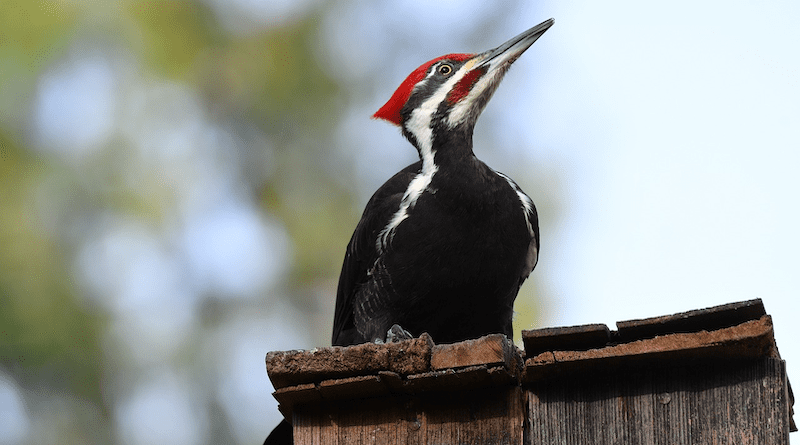Can Cities Make Room For Woodpeckers?
Researchers are deploying the latest mapping techniques to identify the most important suburban habitat for North America’s largest woodpecker.
University of Cincinnati doctoral student Ruijia Hu said wildlife habitat in congested places like southwest Ohio is becoming increasingly fragmented as forests give way to new construction. Eventually, this could spell trouble to an animal with specific habitat needs like Ohio’s pileated woodpecker.
Pileated woodpeckers are crow-sized birds with colorful red crests and striking white facial stripes. They are found in forests from British Columbia to Florida. They have the nickname carpenter birds for their incessant natural woodworking.
“I think they’re beautiful birds. They were the model for the cartoon character Woody Woodpecker,” Hu said.
They prefer mature woodlands with dead timber that conceals grubs and other preferred food. While they are considered a species of low conservation concern, their particular habitat needs make them potentially vulnerable to human development, Hu said.
Pileated woodpeckers peck out cavities in trees for their nests every year, creating lots of valuable real estate for animals like fox squirrels and screech owls.
“They make new nests every year. They won’t reuse old ones,” Hu said. “Other animals depend on them.”
Pileated woodpeckers are reclusive birds that are more often heard than seen. They make a loud, repetitive chucking call that echoes across the forest canopy. Studying them can be especially tricky. So Hu turned to citizen science for help.
To identify where pileated woodpeckers have been seen in Hamilton County, Ohio, home to Cincinnati and its namesake university, she used eight years of sightings collected by birders and logged into the website eBird, a free online tool and app that anyone can use to record their observations and locations.
She overlaid these sightings with remote sensing data and found that corridors along rivers and creeks with abundant mature trees and deadwood helped the birds adjust to their increasingly fragmented urban landscape. One of the best places for pileated woodpeckers in Hamilton County is found along the Little Miami River.
Then they created a model to identify the most critical habitat corridors, which could help park managers and government planners make better decisions about preserving or restoring the most valuable contiguous forest patches.
Hu presented her findings to the American Association of Geographers’ conference in Denver.
Study co-author and UC Professor Susanna Tong said wildlife corridors are becoming an increasingly important tool to save species in urban spaces.
“With fragmented forests, many habitats that were once suitable for wildlife are broken up,” Tong said. “Wildlife is unable to find habitat big enough to meet their survival needs. And even if there are suitable habitats, the distance between them can be too great.
“Wildlife corridors link up these habitat patches. Since wildlife can travel and migrate from one patch to another, the probability of finding food and shelter is higher and they can still survive in the fragmented landscape.”
While the population of pileated woodpeckers is stable today, that hasn’t always been the case, Hu said.
“This bird’s population saw a huge decline in the late 18th and 19th centuries when a lot of forest was converted to agriculture,” she said. “But when reforestation started, it recovered.”
And the United States has lost similar species in the blink of an eye from sudden habitat loss. Now extinct, the ivory-billed woodpecker was once found from Texas to Florida but disappeared in just a few decades in the early 20th century when timber clear-cutting flattened huge sections of the Southeast.
“There are so many species in urban areas that we don’t pay attention to, especially when they’re not considered vulnerable,” Hu said.
With development chipping away at more forest in this congested county, the tipping point could come quickly and unexpectedly, she said.
“You can’t fix it overnight,” Hu said. “It’s not just about planting more trees. The birds need mature forest, so it could take 30 to 50 years to replace their habitat. At least we can protect these riparian forest corridors and see that existing trees reach maturity.”

